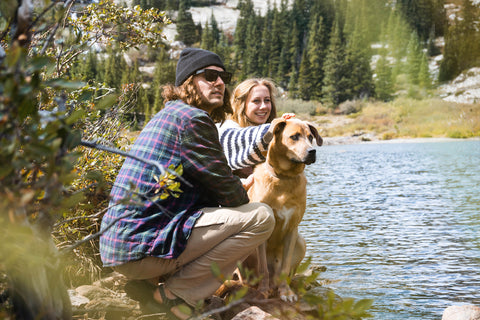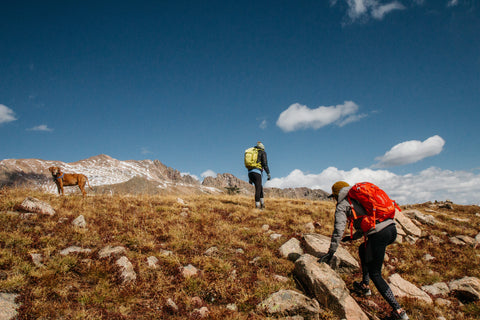How to Best Protect Dog Paws from Rough Terrain

A dog’s paws can really take a beating when traversing rough terrain. Hiking with your pooch over rocky, gravely terrain can easily result in your dog limping with a bloody paw. Before you take your dog out across rough terrain, consider these important steps for protecting their precious paws.
Moisturize
Unless you already apply moisturizer regularly to your dog’s paws, chances are that when you inspect them, you will

find that they look cracked and dry. This condition makes them much more susceptible to tearing and bleeding.
Paw pad creams and moisturizers are great for smoothing and healing cracked, dry paw pads, so apply some to your dog’s paws 2-3 times a week for a month and then as needed.
These creams can also assist with dealing with particularly hot and cold surfaces, but they don’t offer complete protection, so if you are planning on hiking through particularly rough scrambles, jagged rocks or extreme temperatures, then best to leave puppy at home.
Condition them Gradually
If you start off with an extreme hike over difficult terrain, you may end up having to carry your dog for the last two hours due to torn paw pads, and depending upon their weight, that could be far from ideal.

Try to go for a couple of short hikes per week initially to build up your dog’s endurance, as well as to give their pads time to adjust and toughen up. After a couple of months at that pace, they should be well conditioned for longer hikes over tough terrain.
It’s also important to remember to train your pooch with the right gear and equipment. If your dog is wearing a collar, ensure that it is loose enough that you can easily slip your finger underneath, but not loose enough that it could slip off. You will also need a durable leash if you are facing some tough trails.
Trim their Nails
You may have heard that dogs that walk on concrete regularly don’t need to have their nails trimmed, but that is a myth. If a dog’s nails are long enough to reach the concrete then they are already far too long. The concrete will wear them down slightly, but not enough.
Leaving your dog’s nails too long can leave them susceptible to being ripped off, causing an easily-preventable injury. Your dog’s nails should be trimmed every month ideally, or at least bi-monthly. Either buy a pair of nail clippers or drop into your local groomers for a $10 trim - that or a well-deserved full doggy pampering.
Protect their Dewclaws
There isn’t anything you can do to avoid a dewclaw being torn or ripped off, but it’s important to keep an eye on them and treat them accordingly.

Although dewclaw rips aren’t a serious injury, they can be very painful for your pooch and cause a lot of bleeding. Carefully apply a topical antibiotic and wrap the injured claw in a bandage to prevent further injury. It should be fully healed within a week or so.
Check your Dog's Paws as you Hike
Whenever you stop for a quick breath while hiking, take a minute to check your dog’s paws. Check their dew claws and between their toes, too - there could be a pebble or a thorn jammed between them that could cause some trouble if not removed.
You could also apply a little bit of moisturizer to their pads while you’re there, to help keep them supple. Your dog will also get used to you checking their feet and it should become a quick and easy routine in no time.
Buy Dog Hiking Boots
Wearing dog boots might take some getting used to, but can help a great deal to protect their paws on

rough terrain, especially if you find that they seem prone to injury.
Dog boots provide protection from extremes of surface temperature and sharp rocks, as well as preventing them from slipping on wet surfaces. Winter hiking can make them an absolute must, as chemical treatments and salt used to prevent ice notoriously cause blisters, cuts and bloody paws.
Treat Paw Injuries without Delay
Unfortunately, the occasional injured paw pad is a normal part of hiking that may not always be avoidable, no matter whether you do everything right.
Don’t worry! But do treat the injury straight away to avoid further damage or infection. Clean up the wound, dab on some antibiotic ointment and use a bandage to wrap the paw up. Wrapping it well can add some extra padding for the journey back to the car. If it seems too bad though, you’ll have to try to carry your dog back. When you get home, applying some heat or letting your dog rest on a heat pad is an easy and effective way to alleviate pain associated with injury or to relieve tired muscles from all that hiking!
Final Thoughts
Doggie paws can be injured fairly easily but also tend to heal quickly. So long as you take good care of the general condition of your dog’s paw pads and nails and give them time to condition themselves for rougher terrain, you’ve done all you can to prevent unnecessary injury.
If you have any questions about hiking with your dog, feel free to get in touch! You can also check out our shop, which has a wonderful range of products to make camping or hiking with your four-legged friend a comfortable and fun experience.
About the Author: Howie Robleza is a featured author for the K9 Doggy Blog on K9SportSack.com
0 comments



